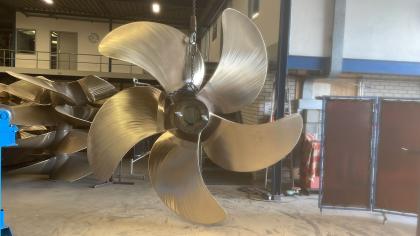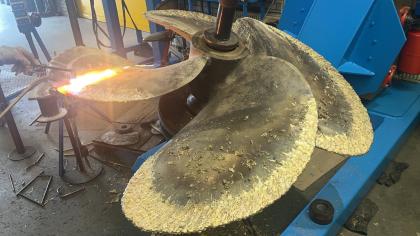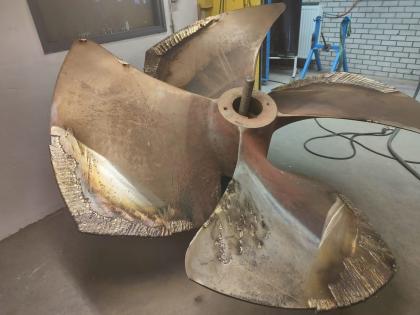welding ship propellers
Ship propellers are designed to resist corrosion, erosion and long-term stress. However, they can suffer from wear and tear due to cavitation, erosion, stones or other objects in the water. By welding the ship propeller, it can be repaired.
Especially in salt water the so-called Aluminum Manganese Nickel Bronze alloy is proven to be the best choice for the application. Usually, this alloy is casted within the similar composition as highest grade for ocean going ships and has excellent mechanical strength that exceeds even most HSLA steels with a strength reaching 700 MPa. Under the different trade names there are many confusions, sometimes standard brass is called Manganese bronze and there are also registered names such as Lima, Superston, Novoston and Cunial and this makes it somewhat difficult to select the right welding wire for the job.

At the end, for welding ship propellors it is preferred to select the welding wire that closely matches the composition of the propeller to fulfill both color match, corrosion resistance and mechanical properties.
Below you will find various solutions.
| Filler metal | Cu | Al | Mn | Ni | Fe | Category |
|---|---|---|---|---|---|---|
| CEWELD CuAl8 | Rem | 8 | 0.3 | - | - | GMAW |
| CEWELD CuAl8Ni2 | Rem | 8.5 | 2 | 2 | 2 | GMAW |
| CEWELD CuAl8Ni6 | Rem | 9 | 2.5 | 5 | 4 | GMAW |
| CEWELD CuMn13Al7 | Rem | 8 | 13 | 2.5 | 3 | GMAW |

Welding ship propellers is a critical aspect of shipbuilding and maintenance, as propellers play a significant role in the performance and efficiency of a vessel. There are some key points to consider in the welding of ship propellers:
Ship propellers are typically made of high-strength, corrosion-resistant materials, such as bronze, stainless steel, or other specialized alloys. It's essential to use welding materials that are compatible with the base material of the propeller. Common welding processes used for ship propellers include gas tungsten arc welding (GTAW or TIG) and gas metal arc welding (GMAW or MIG). These processes provide precise control over the heat input and produce high-quality welds. Proper preparation of the joint is crucial. It involves cleaning the base material, beveling the edges, and removing any contaminants to ensure a strong and sound weld. The specific joint design depends on the propeller's construction. Skilled welders should perform the welding. Techniques like back-step welding, which involves welding in small sections while allowing the previous section to cool, are often used to minimize distortion and stress in the propeller. High-quality welding equipment, including welding machines, torches and wire feeders, should be used to ensure precise control over the welding process

After welding, the propeller may undergo various treatments, such as stress relieving and heat treatment, to reduce residual stresses and improve the mechanical properties of the weld. Non-destructive testing methods like ultrasonic testing (UT) or radiographic testing (RT) may be employed to ensure the integrity of the welds and the absence of defects. To prevent corrosion, ship propellers are often coated or protected with anti-fouling paint or other surface treatments. Welding ship propellers must adhere to industry and maritime standards and regulations. It's crucial to ensure that the welding work complies with classification society rules and marine engineering standards.
Welding ship propellers requires a high level of skill and expertise due to the critical nature of the components and their impact on the ship's performance. It is typically performed by specialized welders and technicians who have experience working on marine structures and components. Additionally, the choice of welding materials and processes should be carefully considered to ensure the longevity and performance of the ship's propulsion system.